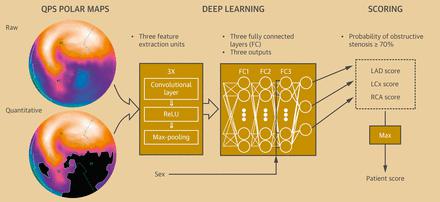JACC: Cardiovascular Imaging ( IF 12.8 ) Pub Date : 2018-11-01 , DOI: 10.1016/j.jcmg.2018.01.020 Julian Betancur , Frederic Commandeur , Mahsaw Motlagh , Tali Sharir , Andrew J. Einstein , Sabahat Bokhari , Mathews B. Fish , Terrence D. Ruddy , Philipp Kaufmann , Albert J. Sinusas , Edward J. Miller , Timothy M. Bateman , Sharmila Dorbala , Marcelo Di Carli , Guido Germano , Yuka Otaki , Balaji K. Tamarappoo , Damini Dey , Daniel S. Berman , Piotr J. Slomka

|
Objectives The study evaluated the automatic prediction of obstructive disease from myocardial perfusion imaging (MPI) by deep learning as compared with total perfusion deficit (TPD).
Background Deep convolutional neural networks trained with a large multicenter population may provide improved prediction of per-patient and per-vessel coronary artery disease from single-photon emission computed tomography MPI.
Methods A total of 1,638 patients (67% men) without known coronary artery disease, undergoing stress 99mTc-sestamibi or tetrofosmin MPI with new generation solid-state scanners in 9 different sites, with invasive coronary angiography performed within 6 months of MPI, were studied. Obstructive disease was defined as ≥70% narrowing of coronary arteries (≥50% for left main artery). Left ventricular myocardium was segmented using clinical nuclear cardiology software and verified by an expert reader. Stress TPD was computed using sex- and camera-specific normal limits. Deep learning was trained using raw and quantitative polar maps and evaluated for prediction of obstructive stenosis in a stratified 10-fold cross-validation procedure.
Results A total of 1,018 (62%) patients and 1,797 of 4,914 (37%) arteries had obstructive disease. Area under the receiver-operating characteristic curve for disease prediction by deep learning was higher than for TPD (per patient: 0.80 vs. 0.78; per vessel: 0.76 vs. 0.73: p < 0.01). With deep learning threshold set to the same specificity as TPD, per-patient sensitivity improved from 79.8% (TPD) to 82.3% (deep learning) (p < 0.05), and per-vessel sensitivity improved from 64.4% (TPD) to 69.8% (deep learning) (p < 0.01).
Conclusions Deep learning has the potential to improve automatic interpretation of MPI as compared with current clinical methods.
中文翻译:

目的本研究评估了通过深度学习将心肌灌注成像(MPI)与总灌注不足(TPD)相比对梗阻性疾病的自动预测。
背景技术由大量的多中心人口训练的深层卷积神经网络可以通过单光子发射计算机断层扫描MPI提供更好的对每位患者和每支血管冠状动脉疾病的预测。
方法共有1638名患者(67%的男性)无已知冠状动脉疾病,他们在9个不同部位接受了新一代固态扫描仪进行的99m Tc-sestamibi或tetrofosmin MPI应激,在MPI的6个月内进行了侵入性冠状动脉造影研究过。阻塞性疾病定义为冠状动脉狭窄≥70%(左主动脉≥50%)。使用临床核心脏病学软件对左心室心肌进行分割,并由专业的读者进行验证。使用特定于性别和特定于相机的正常限值来计算压力TPD。深度学习使用原始的和定量的极谱图进行训练,并通过分层的10倍交叉验证程序对阻塞性狭窄的预测进行评估。
结果共有1,018例患者(62%)和4,797例动脉中的1,797例(37%)患有阻塞性疾病。通过深度学习进行疾病预测的接收器操作特征曲线下的面积要比TPD的高(每位患者:0.80 vs. 0.78;每条血管:0.76 vs. 0.73:p <0.01)。将深度学习阈值设置为与TPD相同的特异性后,每位患者的敏感性从79.8%(TPD)提高到82.3%(深度学习)(p <0.05),每个血管的敏感性从64.4%(TPD)提高到69.8 %(深度学习)(p <0.01)。
结论与当前的临床方法相比,深度学习具有改善MPI自动解释的潜力。











































 京公网安备 11010802027423号
京公网安备 11010802027423号